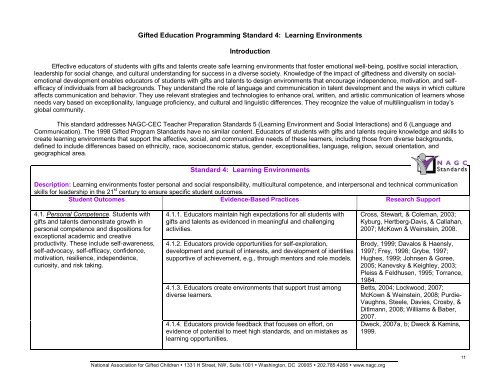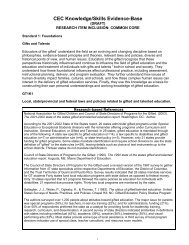2010 Pre-K-Grade 12 Gifted Programming Standards - NAGC
2010 Pre-K-Grade 12 Gifted Programming Standards - NAGC
2010 Pre-K-Grade 12 Gifted Programming Standards - NAGC
You also want an ePaper? Increase the reach of your titles
YUMPU automatically turns print PDFs into web optimized ePapers that Google loves.
<strong>Gifted</strong> Education <strong>Programming</strong> Standard 4: Learning EnvironmentsIntroductionEffective educators of students with gifts and talents create safe learning environments that foster emotional well-being, positive social interaction,leadership for social change, and cultural understanding for success in a diverse society. Knowledge of the impact of giftedness and diversity on socialemotionaldevelopment enables educators of students with gifts and talents to design environments that encourage independence, motivation, and selfefficacyof individuals from all backgrounds. They understand the role of language and communication in talent development and the ways in which cultureaffects communication and behavior. They use relevant strategies and technologies to enhance oral, written, and artistic communication of learners whoseneeds vary based on exceptionality, language proficiency, and cultural and linguistic differences. They recognize the value of multilingualism in today’sglobal community.This standard addresses <strong>NAGC</strong>-CEC Teacher <strong>Pre</strong>paration <strong>Standards</strong> 5 (Learning Environment and Social Interactions) and 6 (Language andCommunication). The 1998 <strong>Gifted</strong> Program <strong>Standards</strong> have no similar content. Educators of students with gifts and talents require knowledge and skills tocreate learning environments that support the affective, social, and communicative needs of these learners, including those from diverse backgrounds,defined to include differences based on ethnicity, race, socioeconomic status, gender, exceptionalities, language, religion, sexual orientation, andgeographical area.Standard 4: Learning EnvironmentsDescription: Learning environments foster personal and social responsibility, multicultural competence, and interpersonal and technical communicationskills for leadership in the 21 st century to ensure specific student outcomes.Student Outcomes Evidence-Based Practices Research Support4.1. Personal Competence. Students withgifts and talents demonstrate growth inpersonal competence and dispositions forexceptional academic and creativeproductivity. These include self-awareness,self-advocacy, self-efficacy, confidence,motivation, resilience, independence,curiosity, and risk taking.4.1.1. Educators maintain high expectations for all students withgifts and talents as evidenced in meaningful and challengingactivities.4.1.2. Educators provide opportunities for self-exploration,development and pursuit of interests, and development of identitiessupportive of achievement, e.g., through mentors and role models.4.1.3. Educators create environments that support trust amongdiverse learners.4.1.4. Educators provide feedback that focuses on effort, onevidence of potential to meet high standards, and on mistakes aslearning opportunities.Cross, Stewart, & Coleman, 2003;Kyburg, Hertberg-Davis, & Callahan,2007; McKown & Weinstein, 2008.Brody, 1999; Davalos & Haensly,1997; Frey, 1998; Grybe, 1997;Hughes, 1999; Johnsen & Goree,2005; Kanevsky & Keighley, 2003;Pleiss & Feldhusen, 1995; Torrance,1984.Betts, 2004; Lockwood, 2007;McKown & Weinstein, 2008; Purdie-Vaughns, Steele, Davies, Crosby, &Ditlmann, 2008; Williams & Baber,2007.Dweck, 2007a, b; Dweck & Kamins,1999.National Association for <strong>Gifted</strong> Children • 1331 H Street, NW, Suite 1001 • Washington, DC 20005 • 202.785.4268 • www.nagc.org11
















